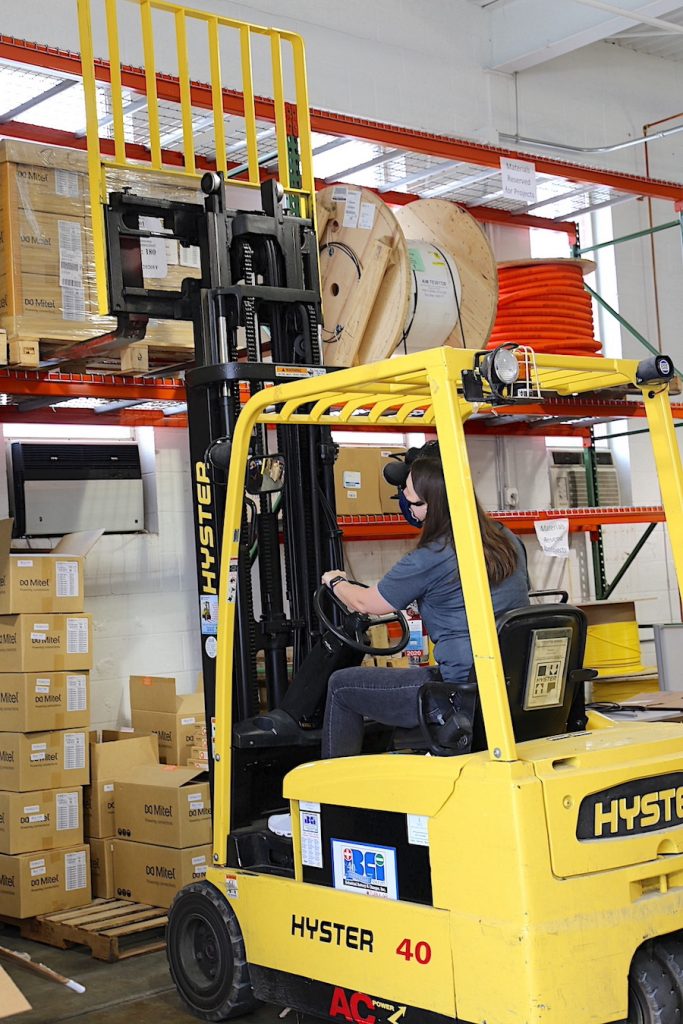
That video game console you covet is out of stock everywhere, the grocery shelf normally packed with canned cat food is bare, and the cost of that bike light in your Amazon shopping cart shot up overnight.
Supply chain woes are clearly disrupting you as a consumer, but have you thought about how those same supply chain issues are hindering ITS’ work for you and the campus community?
Shortages, delays, price jumps — ITS teams are grappling with all that. Wherever possible, they are finding ways to ease the impact. More about that in a minute.
Managers from across ITS shared their experiences, including Networking, Materials Management & Logistics, the Carolina Computing Initiative, the Computer Repair Center, Global Systems Infrastructure, and ITS Classroom Hotline.
Delays can last months
“We placed orders for large quantities of switching and wireless products at the beginning of October. Four months later, those orders are principally undelivered,” said Ryan Turner, Head of Networking.
ITS’ Matt Conley, likewise, ordered equipment in October to replace the Cisco UCS equipment that supports the VMware virtualization platform on which ITS runs its main services. Conley, who is ITS Manager for Storage, Server and Application Virtualization, needs to update that existing equipment because it is six and a half years old. Reliability is crucial.

The new Cisco equipment, Conley said, has been delayed at least until July.
In classrooms and other spaces
ITS’ Classroom Hotline unit also has been contending with delays and unavailable equipment for University classrooms and other spaces. Vaughn Booker, Tier Three Classroom Consultant with the Classroom Hotline, shared three examples.
The Sonja Haynes Stone Center for Black Culture and History sought to upgrade its Hitchcock Room to be Zoom capable. “The purchase order was received back in May, but the equipment wasn’t received and installed until the first week of December,” Booker said.
Likewise, the Morehead-Cain foundation was upgrading its space to be Zoom capable. “Everything except the Biamp Parlé flush mount ceiling microphones were received and installed in April,” Booker said. “The microphones, however, didn’t arrive until late October because of a hard-to-find component inside the microphones.”
For the Hussman School of Journalism and Media, he said, “we barely received the 12 86-inch displays we wanted for Carroll 111 in time for semester startup. Originally we wanted Panasonic professional displays, but their inventory had been completely decimated. We had to substitute with comparable LG displays.”
Laptops and computer repairs
Each year ITS replaces some of the old and out-of-warranty computers used by ITS employees. The 2021 ITS lifecycle and device refresh took more than six months to complete. That’s two to three times as long as usual, said David Eckert, Director for Managed IT Services.

His team placed the order in April 2021. “We periodically received devices until the last of them arrived in September and were subsequently delivered to the designated user in October,” he said.
As for repairs, the worldwide supply chain issues have had minimal impact. Thankfully, manufacturers are required to stock adequate levels of repair components to cover their anticipated device repairs when warranty and accidental damage coverage is offered. That has enabled the ITS Computer Repair Center to continue repairing Carolina’s devices quickly, which also has helped dampen the effects of the supply chain issues, Eckert said.
One exception is monitors. Monitors are not repaired. When they fail under warranty, manufacturers replace them. “The CRC saw significant delays in receiving these replacement monitors,” Eckert said. “The demand for LCD panels skyrocketed during the pandemic and extended the delivery times of replacements by more than five months.”
Reminiscing prompt deliveries
In contrast, in 2019, the CRC generally received replacements in five to 10 business days.
Likewise, the Networking group also was accustomed to getting equipment inside of two weeks, Turner said.

ITS Project Manager Danny Nguyen keeps track of the numbers that quantify the supply chain woes impact on ITS. He leads ITS’ Materials Management & Logistics (MM&L) team. MM&L manages and coordinates logistics for ITS units and other units across the University. That includes such services as purchasing, inventory control, storage and handling, logistics planning, shipping and delivery management, and transportation. MM&L is all about supply chain.
From 2020 to 2021, Nguyen said, “the average number of days between a placed order and when it was received has gone up across the board between our vendors.” In fact, the average, in a tally of those vendors, has increased by about eight days.
Prices escalating even 25%
Of course, the length of time until delivery isn’t the only thing that’s increased. As you know from the things you’re buying in your own life, so has price. Anecdotally, everything is more expensive.
“All of our equipment costs have gone up significantly since the start of the pandemic,” Networking’s Turner said.
“Depending on the specific items, costs have gone up on average of between 5-10% from 2020 to 2021,” Nguyen said. Some items, though, have skyrocketed by 25%, he said. A 1,000-foot box of Cat6e Ethernet cable is one such example.
Early planning and consulting
These delays, shortages and escalating costs significantly affect planning efforts for ITS. Carolina is a big institution. It can’t adjust its buying as easily as you as a consumer switching brands or stores. As part of that big institution, ITS needs certainty and equipment in a timely fashion to support the important work of the University.

“Without a reliable delivery schedule, we have to be more selective where we use equipment, as we don’t know when we’ll get more equipment in to replace it,” Turner said.
He and other ITS unit leaders stressed that they need to be brought into the conversation earlier in the process, as short turnaround times for projects are almost impossible.
Solutions large and small
ITS teams are adjusting. Where they can, they have found ways — both big and small — to lessen disruptions caused by global supply chain issues.
Take the Carolina Computing Initiative (CCI), for instance. Each year since ITS started awarding CCI laptop grants in 2000, the grants have expired on October 15. But in 2021, 30 students had not yet received their laptops by this date due. The delay was caused by repeated component shortages and customs and delivery delays.
“In October 2021, we extended the availability of CCI laptop grants for the first time ever,” Eckert said. “We postponed the expiration date for the grants into December.”
Teams with ITS — Enterprise Applications and Finance & Administration — and outside of ITS — the Office of Scholarships and Student Aid and the Student Stores — made necessary adjustments to work around this issue.

The impacted students were offered a loaner laptop while they waited for their new one to arrive. That was helpful but not ideal, Eckert noted.
In an additional way of easing the impact of supply chain issues, CCI adjusted its purchasing projections and Lenovo significantly increased the number of CCI model devices it keeps at its Guilford County facility for UNC-Chapel Hill purchases.
In 2019, ITS projected the inventory of CCI model Lenovo devices monthly and it adjusted inventory stocking levels weekly. “In early 2021, we began projecting six months of purchasing volumes and ordering hundreds of each model for inventory stocking. And still we experienced shortages and delays,” Eckert said.
Mitigating impacts
The MM&L team, meanwhile, has established a variety of ways to mitigate the cascading supply chain risks due to backlogs and shortages. Those approaches, Nguyen said, include:
- Communicating upfront with customers and transparently keeping them regularly updated on the status of their material orders
- Partnering with vendors to readily have stock on hand for certain items in their warehouses reserved for Carolina, such as Cat6e and Cat6a Ethernet cable boxes and electrical tap boxes
- Working with vendors to identify potential bottlenecks and lead time issues for specific products
- Regularly reporting and monitoring ITS Warehouse “shelf life” and preemptively adjusting minimum and maximum quantities
- Staying ahead of material shortages by having sufficient stock and not needing to re-order anytime soon. In other words, the team may place bigger orders for items that may have longer lead times.
